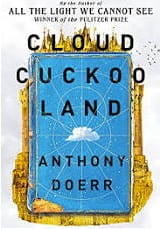On my third attempt I managed to get into the book and I am so glad I did. I loved it!
The story is one that spans time from long into the past to well into the future and is a series of stories that eventually interlock. We have Anna and Omeir from the 1400s, Zeno from the 1950s to 2020 and Konstance who takes us to mission year 65 and beyond in 2146.
What they each have in common is that they come across a book written by Antonius Diogenes in around CE 200. It is one of 24 books that have become mixed up in order and damaged as time has passed. But, it has worked its magic on all of them. It was originally written for a niece to keep her well and prevent her from dying and its use across time has had the same effect.What Cloud Cuckoo Land is concerned with is how this story has travelled through time and how it brings the seemingly disparate characters together.
For as long as we have been a species . . . by telling stories, we have tried to defeat death.
p212-213
So on one level the book is about the power of stories to stand the test of time and to provide meaning for people but this story is also a tribute to librarians – those who used to house knowledge in books and who would introduce children to the ancient myths and their power. They also understand that all the knowledge in the world can’t be known by any one person or entity and are there to share it with everyone, finding the right information for you at the right time. However, a corporation set up a scheme to collect all the information in the world into a library called Sybil who can answer anything.
At this point when there is no librarian to mediate information and to support those searching, a vulnerable boy, Seymour, starts investigating information online and is eventually groomed into dangerous activities out of concern over the loss of natural habitats and always being an outsider.
But Seymour is not the only outsider. There is Omeir in the 1400s whose family has to up sticks and move because he was born with a hare lip and he was considered a curse, a bringer of bad luck. His family lived away from others but he worked well with ox and settled into a seasonal world of farming, understanding the land and being compassionate with animals.
Meanwhile, far away is Anna who lives with other embroidresses but can’t sew to save her life. She is more capable of climbing and escaping which is when she discovers an old monastery with its books still intact. She takes artefacts from the building and sells them until war is declared on their city and they are trapped within the walls starving.
Konstance lives in the future on a spaceship, escaping earth with her parents. The digital library, Sybil is aboard the ship and is there, programmed to keep the people safe. All goes well until people start to become ill and die – how can this happen in a closed environment? Stories are often told to comfort people and this is the primary aim of Sybil.
And finally, there is Zeno who during the Korean war meets a teacher of greek who shows him how to understand and translate it.
These character’s stories are told bit by bit and slowly the interlocking is revealed – some of it quite unexpected.
The book argues for more attention to be paid to the climate crisis with the use of prime land for wildlife being bought up and converted into housing. Whilst this storyline takes place in America where there is far more land than we have, loss of wildlife is still an issue. It does though come with a warning tale involved and is powerful when contrasted with Oemeir’s story. It also highlights the issues for those who are living not far from, if not on, the poverty line
The people in Eden’s Gate houses fill their trash cans and pilot SUVs between their two homes and play music on their Bluetooth speakers in their backyards and tell themselves they are good people. When in truth the’re participating in a pyramid scheme that’s chewing up everybody at the bottom, people like his (Seymour’s) mother. And they’re all congratulating themselves for doing it.
p508
Perhaps the most fun for me in this book was watching the disparate parts fall into place, like a puzzle that you have been worriting over and finally solve. It has a story within a story and is a love letter to stories, reminding us of all the different ways stories can be lost: losing the language, floods, droughts, war, theft, damage and forgetting and their power when they survive.
As Christopher Booker says all stories are basically one story – what it means to be human. And here it means love, loss, heroism and searching for a better place, often linked with the power of coming home.
. . . all times and all stories being one and the same at the end.
p581
